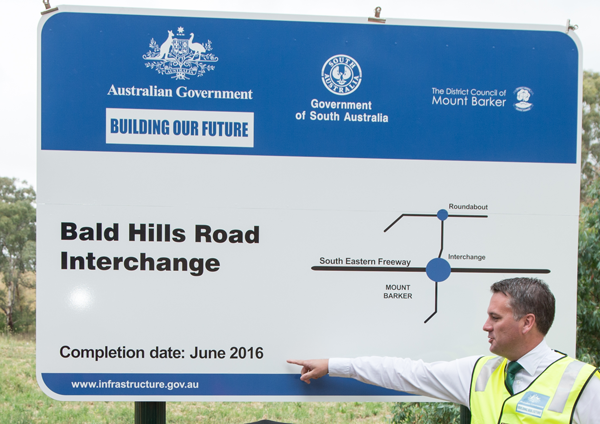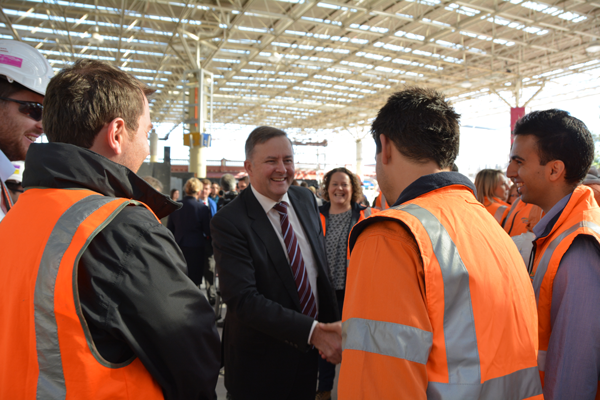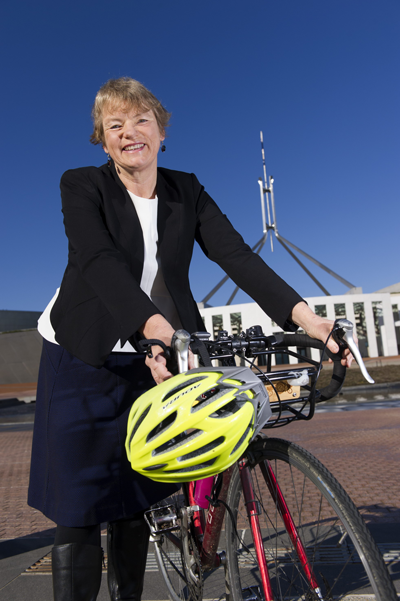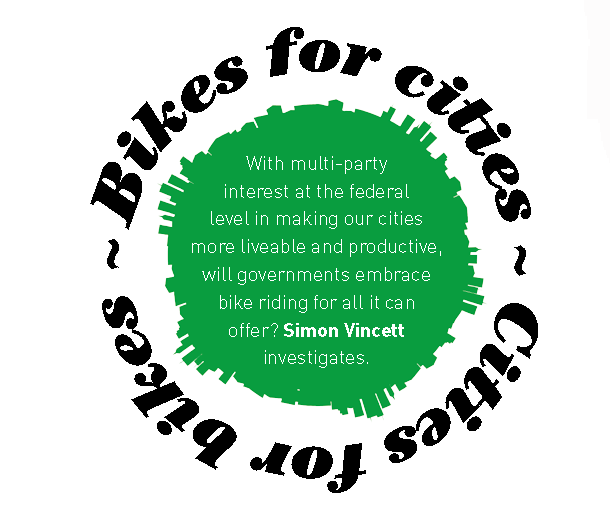With multi-party interest at the federal level in making our cities more liveable and productive, will governments embrace bike riding for all it can offer? Simon Vincett investigates.
Advocates of active transport in Australia could heave a sigh of relief when Malcolm Turnbull replaced Tony Abbott as Prime Minister in September 2015. Gone was a head of government ideologically committed to more roads for cars as the sole solution to transport demand. Now in power is a man who proudly fills his Twitter feed with selfies from ferries, updates from trains and declarations of his favourite, and second favourite, local bus routes.
In fact, Turnbull has explained via Twitter—no mean feat in 140 characters—that he himself relies on public transport to avoid peak hour traffic. The regular user of public transport in cities and of trains to regional centres, contrasts with the choice of his former Liberal colleague, Bronwyn Bishop, to take a helicopter for the 80km trip from Melbourne to Geelong.
In the reshuffle of the personnel of his new government, Turnbull took the opportunity to create a new Ministry of Cities and the Built Environment. It’s no small thing to create a new ministry. The administrative palaver of drafting the remit of a new department and the subsequent impact on other departments is only undertaken because either there’s a pressing issue to address or because it’s politically advantageous.
But whether Turnbull really believes our cities need enhancing for the good of the nation or whether he’s appealing for the allegiance of city voters, the deed is done. So, for the life of the Turnbull government at least, there is currently a politician on the front bench whose express job is to make Australian cities world-class in liveability, connectivity and productivity.
The man tasked with the job of leading Turnbull’s new Ministry for Cities and the Built Environment is Jamie Briggs. Previously an Assistant Minister in the Infrastructure portfolio, Briggs is a lower house MP for the seat of Mayo, encompassing the Adelaide Hills, Fleurieu Peninsula and Kangaroo Island. His electoral office is in the regional centre of Mount Barker.
Malcolm Turnbull is the member for the inner-city electorate of Wentworth, the part of Sydney in which he has lived all his life. Lucy Turnbull, his wife, is a highly successful businesswoman and was the first female mayor of Sydney in 2003. She continues to be involved in the think-tank, Committee for Sydney.
For Malcolm Turnbull—whose own career has spanned journalism, law, software development and investment banking before politics—cities are the natural setting for the innovative industries that will drive the Australian economy in the current era, now that the resources boom is over. His brief to Minister Briggs is to guide Australian cities to the sort of world-class liveability and productivity that attracts the best and brightest individuals and businesses.
“Governments that think they can tell people what they’re going to do have been proved wrong.” Briggs
Melbourne has been named the world’s most liveable city by The Economist for the past five years. The Age newspaper reported that most Australian metropolitan centres featured highly in the 140 cities listed, with “Adelaide fifth, Sydney seventh, Perth eighth and Brisbane 18th. None of these cities saw their ranks change in this year’s report.”
But there’s obviously more that must be done to enable a world-class knowledge industry in Australia, suggests Minister Briggs, because many of our brightest brains leave our shores for overseas knowledge-economy centres, such as New York City and Silicon Valley.
In an interview with Ride On, soon after taking up his new ministry, Briggs explained his view of how the liveability of our cities impacts the economy: “If you look at the evidence—I’ve been doing a lot of reading over the last few weeks in this respect—cities are becoming vital to economic growth. Our economy is driven by our knowledge; it’s driven by smart people coming up with smart ideas. Worldwide they want to be around each other. We need to ensure that people who are clustering for their work have the opportunity to live near their work.
“That is a challenge that many of our cities now face. That gets to providing the amenity—whether it be access to public transport, whether it be access to roads, buses, whether it be access to cycling infrastructure—which allows easy movement around. These are the discussions that states really need to have; a deep think about [what] we need to be involved in, encouraging them to plan to ensure that the vibrancy and liveability of cities are paramount in decisions that are taken.”
Does Minister Briggs see bicycles playing a transport role for people in urban centres?
“Well they already do,” says Briggs. “There are more people on the roads on bikes now than there have been for a very long time. There are numerous reasons for that, such as the capacity to move around suburbs and cities, and an attempt to stay healthy.
“The states are taking steps to improve the environment for interaction between cyclists and road users. There is I think a lot more attention on the mix of modes—not just mass transit, not just roads—but what walking needs, what cycling needs in how we develop cities. Being able to ride to the station on reasonably clear paths and roads which are safe for people to use.”

Minister Briggs keeps returning to the state governments because they remain responsible for the actual building of transport infrastructure. In fact, his ministry—which sits within the larger Ministry of Environment—has no budget of its own. Briggs has described the Cities Ministry as a primarily economic portfolio, in the sense of carefully leveraging existing funds.
“The trick here is to use limited resources effectively,” he explains. “It’s about getting the best outcomes from the Commonwealth spend rather than spending any more. We spend a lot now. This portfolio won’t be successful if the states aren’t on board and if local governments aren’t on board. Obviously we won’t always agree but we need to work closely.”
But does it have to be so complicated? Across the Tasman in New Zealand—which admittedly benefits in this regard from one less level of government—has committed to spending NZ$350 million dollars in three years on bicycle infrastructure.
Dougal List, National Cycling Manager, explained at Bicycle Network’s Bike Futures Conference in Melbourne that the New Zealand Transport Authority had included cycling in its top six priorities.
The government had initially seen bike riding as a jobs creation opportunity via bicycle tourism, and spent $50 million with another $50 million in matching funds to build the New Zealand Cycle Trail. That project won the government an enormous amount of acclaim across the community and gave it a strong basis of support when it decided to make the big investment in urban cycleway infrastructure.
List explained that local riding amenity is an investment in urban renewal because bike infrastructure makes great places to live, gets kids riding and is for the whole community. His role did not exist until recently but now cycling had been integrated into transport.
List said that there would be about 54 major projects developed across the two islands, involving 20 cities, focusing on new riders. Previously the total bike spend was about $80 million over three years, so more than doubling the rate of construction was a big challenge. The target for cycling participation has been set at 10 million trips by 2019.
Minister Briggs, however, in true Liberal fashion, sees the market as the primary force directing the social–economic development of Australia: “We are very ambitious if we think we can out-guess the market. Governments that think they can tell people what they’re going to do have been proved wrong. Twenty years ago people presumed that with the advent of the internet that jobs would diversify, that people would work in the suburbs or where they lived. But that has not been true, right across the globe. Between 41st Street and 59th Street in New York City are more jobs that in New Hampshire and Maine combined, with a higher payroll than Oregon or Nevada. The opposite has been true and that’s been driven not by government decision making but by smart people. The same can be said of Silicon Valley.”
The Labor spokesperson on cities, Anthony Albanese, is a strong advocate for urban renewal through transport diversity. As Member for the inner-Sydney electorate of Grayndler, Albanese was Minister for Infrastructure and Transport from 2007 to 2013. When Labor lost office, Albanese retained the Shadow Ministry of Infrastructure and Transport. Then in September 2014 the Shorten Labor Opposition created the Shadow Ministry of Cities that Albanese also holds, predating Turnbull’s move by more than a year.
Albanese told Ride On he sees, in the Turnbull Coalition Government’s new Ministry for Cities, a recognition that this area needs federal leadership. “It is positive recognition of what Labor has been saying as part of our core function going back to 1972 with the election of the Whitlam government. In his campaign speech, Whitlam outlined very clearly that a government that is not engaged in cities, has nothing to say about the nation’s future. Now that is even more the case because of the growing significance of cities to the national economy and to people’s lives.”
Albanese is proud of the work he has done in this vein: “We produced a national urban policy Our cities, our future. We produced national urban design protocols. We established the Major Cities Unit which produced three State of Australian cities reports. We had—importantly for the cycling community—an active transport policy.
“For example, projects like the Perth City Link project funded primarily by the federal government in conjunction with the WA government. Not only will that improve the liveability and amenity for Perth by uniting the Perth CBD with Northbridge, we insisted that in the upgrading of the rail stations that there be lock-up bicycle facilities to encourage the use of public transport.”

As a former Deputy Prime Minister who was concurrently Minister of two portfolios and Leader of the House of Representatives, Albanese questions the leadership on show in the Turnbull Government in this area.
“Now Malcolm Turnbull has changed the rhetoric but we are concerned that it actually leads to real outcomes. A concern that we have, is that it is unclear exactly who is in charge of what, with the structure of the Minister for Cities, Minister for Major Projects, Minister for the Environment and Minister for Infrastructure.”
In the Turnbull government the Ministry for Cities and the Built Environment sits within the Environment budget, with Major Projects and Infrastructure under the Infrastructure budget.
“This is the big problem,” says Albanese. “Warren Truss [the Infrastructure Minister] has not changed his views. He had these views for his entire political engagement. His views of infrastructure is regional roads as the priority rather than any engagement in our cities, with the exception of major toll roads without business cases. It is of real concern that if you don’t have a bureaucracy then you won’t get outcomes. Both Truss and Jamie Briggs have made comments that there aren’t public transport projects ready to go. Well, there are. The Melbourne Metro, the Cross River Rail in Brisbane, the Parramatta to Epping rail line in Sydney and the ACT light rail to name four.”
“It is unclear exactly who is in charge of what, with the structure of the Minister for Cities, Minister for Major Projects, Minister for the Environment and Minister for Infrastructure.” Albanese
Albanese claims form on providing specifically for bikes and as part of integrated transport: “We delivered the largest ever Commonwealth funding by a long way of cycleways around our major cities in particular but also our regional cities.
“The regional rail link in Victoria that was funded by the federal Labor government and opened in June was the largest ever investment by the Commonwealth in a public transport project at $3.2 billion. There at Tarneit station, which I was at the opening of, there is a sizeable bike lock-up facility that will ensure that active transport will have a proper role, which in turn increases the use of the rail line—it’s a common sense approach.
“We know that cycling is increasing as a mode of transport and it needs to be factored in so that, one, cycling is not an afterthought, and two, cycling isn’t seen as something that is recreational. It can be recreational but can also be just for day-to-day use and how people get from A to B. We know from overseas experience that if it’s made safe and if it’s made convenient that more people will take it up and there are massive advantages for reducing the carbon footprint of transport and for increased outcomes for individuals in terms of health, which therefore reduces the requirements on the health budget.”
A commitment to facilitating bike riding, for all its benefits, has been enshrined in Labor’s policy framework, the National Platform, as of the 2015 update.
Albanese has shown vision befitting the Turnbull rallying cry to create world-class transport, saying: “As we know, the greatest way to have urban renewal is public transport. Have a look at projects like the Regional Rail Link in Victoria and you can see how successful urban renewal projects can be.”
But Labor’s model is for the government to foot the bill for major infrastructure. Does the Australian public have an appetite to go into debt sufficiently to get projects done?
“I think the Australian people understand and draw a distinction between capital investment and recurrent expenditure. Investment in nation-building infrastructure that produces a return to the government through higher productivity and higher economic growth can make absolute sense and that’s a case that I put forward at the Infrastructure Partnerships Australia Conference and it’s what we put forward in the policy release from Bill Shorten just two weeks ago [Oct 2015].
“Australians do understand that none of them would own a house if they had not invested by borrowing to ensure their economic future. It’s no different from a national government drawing a distinction between borrowing for investment—at record-low interest rates—which are more than paid back by increases in economic growth, particularly in our cities.”
The Greens spokesperson for Transport and Infrastructure, Victorian federal Senator Janet Rice, sees vested interests and conservatism as entrenched obstacles to transport diversity in Australia. She told Ride On: “We are still in the model of car dominance and the pressure for that to continue is still very strong. We’ve got large road projects that suit the interests of the road builders. They also serve the political interest because they are seen as being politically popular and big and shiny to open and at a level to have electoral influence. We’re not going to have a brand new glorious day of liveable cities without actually challenging those pressures from the road builders.”
Rice sees evidence of an appetite for change away from car-centric living: “The last Essential Research Report that had 57% of Australians agreeing that if it’s a choice between spending money on public transport or roads, they’d rather see it spent on public transport.
“It’s not because we don’t know what to do and it’s not because Australia is exceptional … The thing that we’re lacking here is political will, full stop.” Rice
“People are increasingly realising that there are big benefits in a choice of other modes. For me as a Green, I’m not against cars, I’m not against roads; people just need to have the choice of being able to choose other modes. I think a healthy mix for Australian cities would be for a third of trips being taken by car, a third by public transport and a third by active transport. It would be quite doable and it would still have plenty of road space for cars for those journeys that are best by car.”
Vested interests hold sway, suggests Rice: “One of the things I’ve learned in the years of working in transport advocacy and looking at transport systems around the world is that it’s not because we don’t know what to do and it’s not because Australia is exceptional and different from everywhere else in the world. The thing that we’re lacking here is political will, full stop. If we had the political will we could implement it and most people would be better off, happier, healthier in a larger degree and we would have more efficient cities.”

There’s even a strategy that’s left ignored, points out Rice: “The National Cycling Strategy is going nowhere at the moment, and it’s because it doesn’t have measureable targets. Essentially, all the federal government sees its role as is to have a strategic overview and it’s up to the states and local government to implement it. But we know that state and local governments haven’t got the funds. Most of the money in Australia comes in at the federal level and a serious amount of money has to come out to address cycling.”
Bicycle Network has expressed similar concerns about the National Cycling Strategy.
So do the Greens support the introduction of a national bike infrastructure fund? If so, how much funding should be made available?
“The Greens position is that we’re advocating for a fund of at least $80 million a year on-going, which would allow for state and local governments to bid for that money,” explains Senator Rice. “Probably you’d have a situation where you’d have matching grants but not necessarily because matching grants often favour the local governments that have actually got the capacity to fund things themselves whereas there might be some really valuable projects that local governments just have not got the money to invest in.”
Ride On put the question to each of these three federal politicians that Bicycle Network wants answered: “Would your party require that all infrastructure projects funded through federal programs consider the inclusion of all transport modes—particularly bike riding and walking?”
Greens Senator Janet Rice says “Yes. Although, we need to go back to first principles and look at the purpose being served by the investment—what’s the transport need being served and how do we meet it. At the moment these things are planned: “We’ve got a transport need so here’s a road project to solve it and we’ll tack on a bike path alongside it to make it look like we’re doing something for bikes as well.” Whereas if we look at a transport issue, a congestion issue, a bit more holistically, it may be an upgrade of an arterial road plus improvement in public transport, plus putting in an off-road path that might be in a slightly different direction. Seeing the problem holistically rather than having a solution of a road to solve a perceived problem.”
On behalf of Labor, Anthony Albanese emphatically agrees.
“Oh absolutely,” he says. “That’s part of what we did as our active transport policy when we were in government; that had to be part of the business case. Now, there might be some cases where that’s not possible but it should certainly be considered, just as smart infrastructure should be considered, which is the use of new technology to make sure you get the most out of the asset. That just makes sense.
“The three mantras that we had in government were ‘productivity’, ‘sustainability’ and ‘liveability’. Increasing the use of cycling as a mode of transport, and walking, ticks all of those boxes and governments should facilitate that, because it’s good for individuals as well as for governments in terms of health outcomes, environmental outcomes and economic outcomes.”
“If Anthony or the Greens tell you that the federal government somehow has a better idea of how to plan train stations I think you have to give it a skeptical eye.” Briggs
Minister Briggs replied: “It’s up to the states to identify what are the key requirements of their particular cities. We don’t know what their cities need. Any federal politician or bureaucrat that tells a state and local government what is best for their city is making a mistake. The truth is our communities know our cities better than anyone. If Anthony or the Greens tell you that the federal government somehow has a better idea of how to plan train stations I think you have to give it a skeptical eye.”
For the immediate future, there’s hope offered in the Turnbull concept of city liveability, though you have to wonder how Briggs, based in Mount Barker and with no history in active transport, can truly get his head around the transport diversity element of his complex portfolio. His leadership in this portfolio hardly inspires confidence when he declares: “This is not about the Federal government coming in and taking over.”
On the other hand there is Malcolm Turnbull, who gives the impression that if the bike riding culture and environment of our cities improved, we could see our Prime Minister riding to official engagements, as does the Prime Minister of the Netherlands and the Mayor of London, Boris Johnson. However, just as our second Prime Minister, Alfred Deakin, was fined for riding through Melbourne’s Treasury Gardens in 1906 while in office, it won’t be an easy ride for the current Prime Minister either.
Ride On content is editorially independent, but is supported financially by members of Bicycle Network. If you enjoy our articles and want to support the future publication of high-quality content, please consider helping out by becoming a member.

